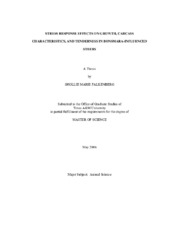| dc.description.abstract | Half-blood Bonsmara steers were evaluated for temperament during stressful situations to discover the relationships between behavioral stress responses, growth, carcass characteristics and tenderness. Two experiments were conducted to evaluate behavioral stress responses at different stages in the U.S. beef production system with growth, carcass characteristics and tenderness. The first experiment evaluated stress responses at both time of weaning and at the beginning of the feedlot period on half-blood Bonsmara X Beefmaster steers. Steers (n=156) were weaned and paired to destinations of either Uvalde or Overton for winter grazing. At weaning cattle were weighed, and temperament measurements were recorded. After grazing winter pastures, cattle entered the feedlot and were measured for temperament, weight, and condition and frame scores. Cattle were harvested in two groups; each group was selected for harvest when they reached a backfat of approximately 7 mm. Backfat endpoints were determined by visual assessment and ultrasound. Carcass data were recorded approximately 36 hrs post-mortem, and 2.5cm steaks were removed from the 13th rib for Warner-Bratzler shear force determination. The second experiment involved Bonsmara X Angus (n=207) steers grazed on wheat pasture and fed at Cattletown feedlot near Hereford, TX. The steers were evaluated near the beginning and end of the finishing phase for performance and temperament. They were harvested in two groups; each group was selected for harvest when they reached approximately 7 mm of backfat as determined by visual assessment and ultrasound. In experiments 1 and 2, behavioral or temperament measures and hormonal responses were related to each other. It appeared as cattle become acclimated to the production system, temperament measures lose their predictive ability. In Experiment 1, weaning exit velocity appeared to be more related to economically important traits such as ADG (r = -0.26), ribeye area (r = -0.37), and Warner Bratzler shear force (r = 0.27), although beginning feedlot exit velocity was associated with feedlot weights (r = -0.30). In Experiment 2, end feedlot measurements tended to be more associated with feedlot weight (r = -0.20), but there did not seem to be any high relationships with carcass characteristics and tenderness. | en |


